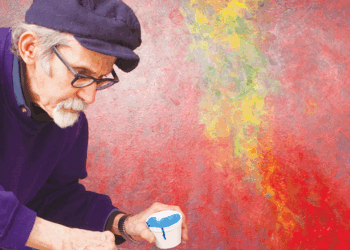Reviewed by NEAL GENDLER
Remember the wire-service photo in 2000 of a bleeding civilian sitting in front of a shouting, helmeted, club-waving Israeli border policeman?
The caption said the man was an Arab injured in a riot; the logical inference was that he’d been beaten by Israelis, likely the uniformed man. But as Errol Morris says in Believing Is Seeing, “nothing is so obvious that it’s obvious.”
In fact, the injured man was a Jewish student from Chicago who’d been pulled from a taxi and assaulted by an Arab mob. The border policeman had rescued him.
By the time a correction ran, the damage to Israel had been done.
Was the caption the result of inadequate reporting or of leaping to a conclusion that fit the writer’s beliefs? In his unusual book, Morris counsels against drawing conclusions about a photographer’s motivation or the people and objects shown.
“We can make false inferences from a photograph,” says Morris, whose documentary films include Standard Operating Procedure, about the notorious Abu Ghraib prison photos, and the Academy Award-winning The Fog of War. “Much of the problem comes from our collective need to endow photographs with intentions.”

But photography both represents and hides things, according to what is and is not depicted, and “the coupling of photography and language provides an express train to error.”
Morris devotes a chapter to Lebanon, including the photo of a vividly colored Mickey Mouse toy lying on a street littered with glass and small debris from the bombing of a nearby apartment building. One could interpret the photo as an illustration of the results of bombing or as Israeli brutality against Lebanese civilians. Some claimed the photo was staged.
The photographer, Ben Curtis, denies political intent or placing the toy, saying that he saw and photographed it while hurrying along. I tend to believe he didn’t stage the photo; he’s a ranking Associated Press employee, not a freelancer, and the AP has strict standards. But what of similar toy images? Morris supplies five from Reuters, three by the same man.
Photo-doctoring software has made people more suspicious, and rightly so, he says, illustrating with photos from Lebanon in which bomb smoke was digitally enhanced.
Morris begins with an exhaustive discussion of two famous Roger Fenton photos of a road near Sebastopol, shot in 1855, during the Crimean War. Both are taken from the same spot, but in one, cannonballs are on the road; in the other they’re not. Over the years, people concluded that the bare-road photo was shot first, then the balls were placed on the road for artistic or dramatic effect. Morris questions this conclusion, and eventually, computer analysis provides an answer that appears definitive.
The book also discusses Depression-era photos of poverty that may not have been candid, but that the photographer considered faithful reproductions of what he believed he saw. “His meaning is overwhelmingly clear,” Morris says. “Photographs concern belief, not truth.”
Another topic is Abu Ghraib prison, including a photo of an Iraqi falsely claiming to be the man standing under a hood on a box, and a photo of a woman soldier smiling near a dead Iraqi. But she was not joyful.
“Photographs attract beliefs the way flypaper attracts flies,’ Morris says. The cliché is that the camera doesn’t lie, but “photographs allow us to think we know more than what we really do. We can imagine a context that isn’t really there,” one not independent of our beliefs.
Although the beaten-student incident is not in Morris’ book, a Google search turns up two wildly out-of-context, chutzpadik uses of the photo, posted by the pro-Israel organization Honest Reporting: The student’s bloody image was used for a time in Arab propaganda, as if he were an Arab beaten by Israelis.
Was a famous Dust Bowl photo of a father and sons in a sandstorm staged? In one sense, it matters, says Morris — who disapproves of faked photos — but in another sense, “all that matters is the image, which extends through time, the memory of the storm…. It is the idea that the photograph captures that endures.”
***
Neal Gendler is a Minneapolis writer and editor.
(American Jewish World, 9.2.11)


















